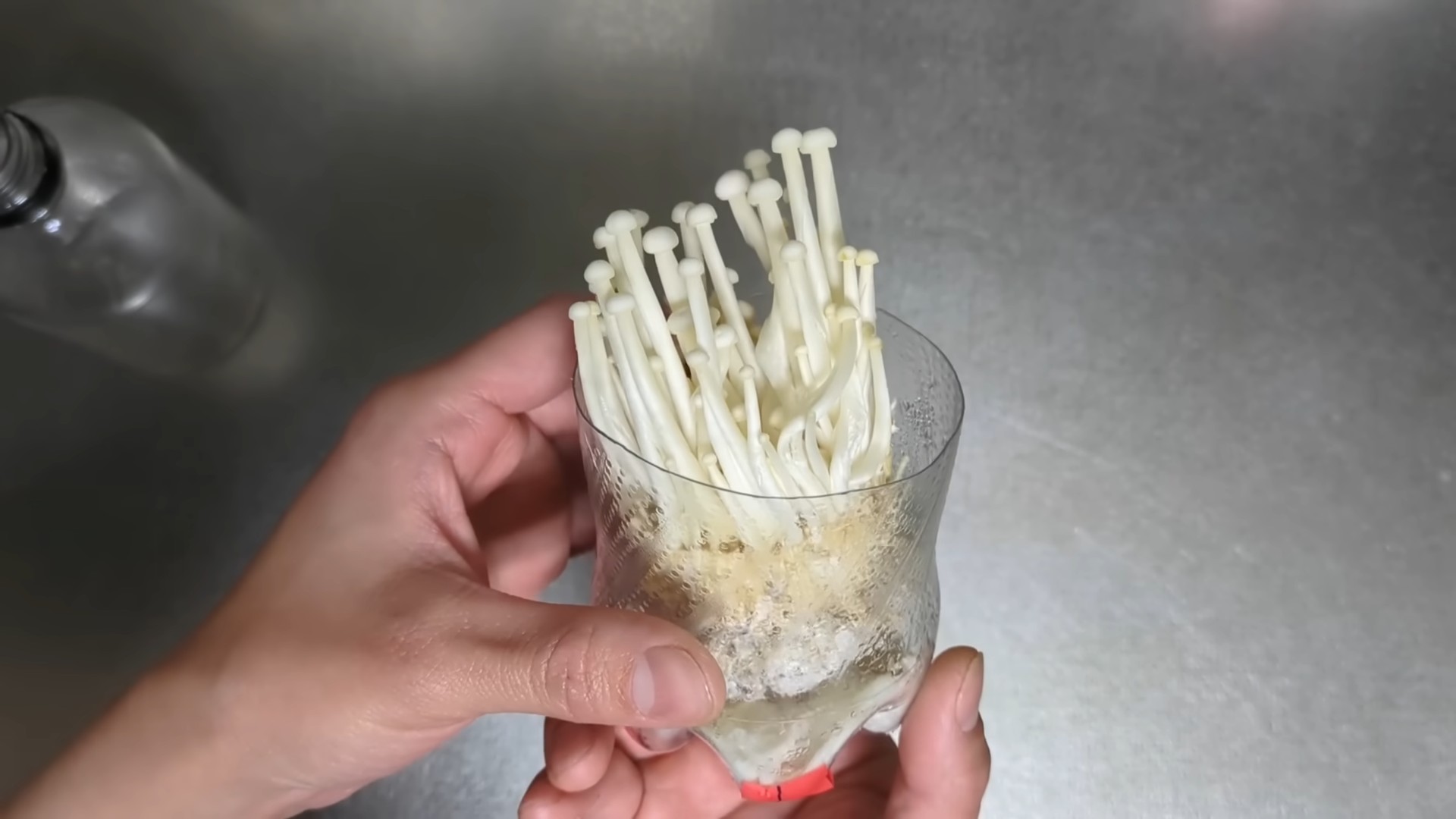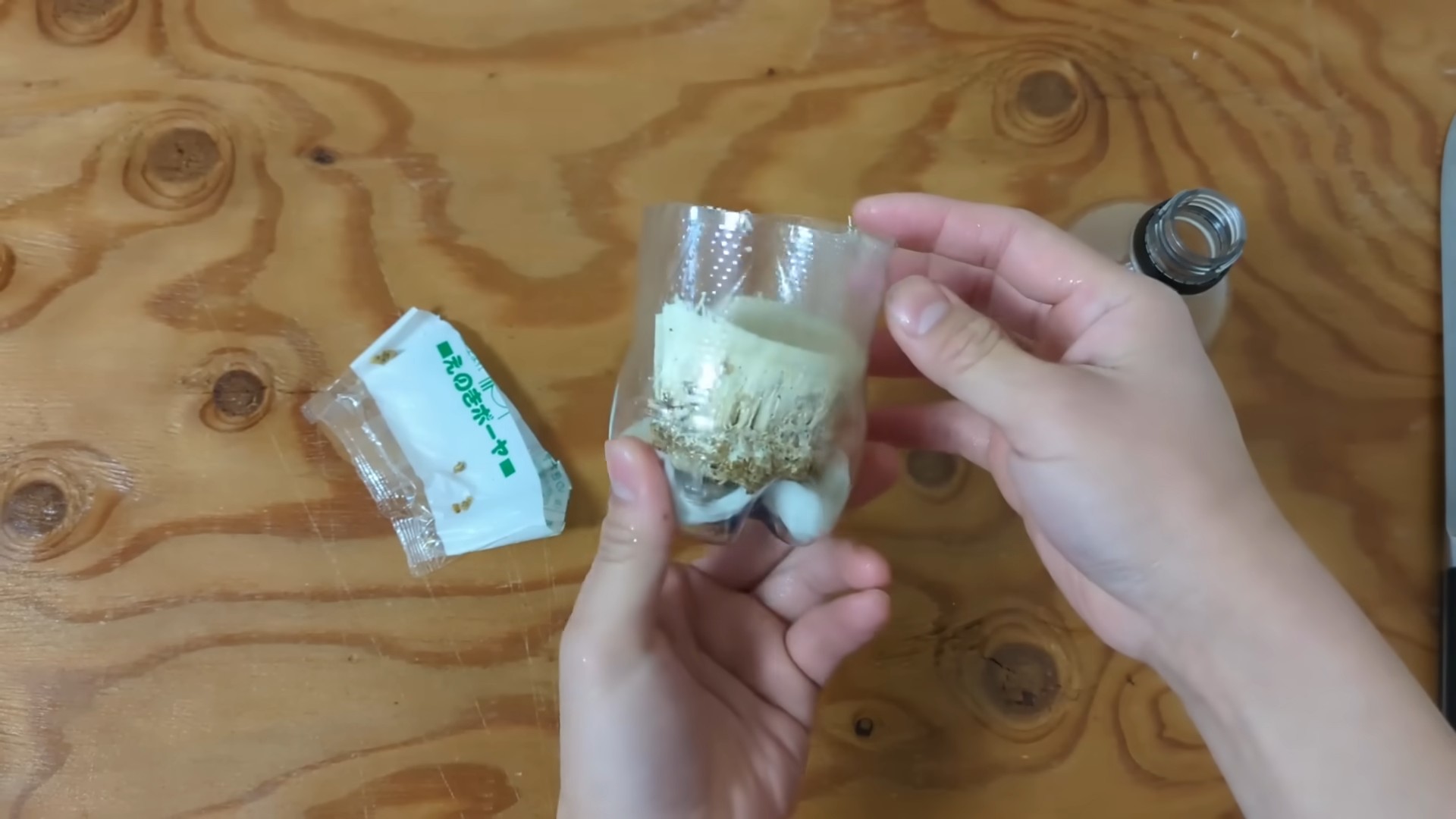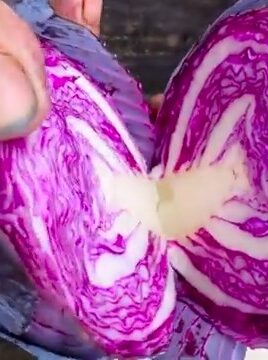Enoki Mushroom Regrow At Home: Imagine harvesting fresh, delicious enoki mushrooms right from your kitchen! It sounds like something out of a gourmet magazine, doesn’t it? But trust me, it’s easier than you think, and I’m here to show you how with this simple DIY guide.
Mushrooms, including the delicate enoki, have been prized for centuries in Asian cultures, not just for their unique flavor and texture, but also for their medicinal properties. From stir-fries to hot pots, enoki adds a delightful crunch and subtle sweetness. But constantly buying them from the store can get expensive, and let’s be honest, sometimes they’re not as fresh as we’d like.
That’s where this amazing DIY trick comes in! Learning how to Enoki Mushroom Regrow At Home is not only a fun and rewarding project, but it’s also a fantastic way to reduce food waste and enjoy a sustainable source of fresh produce. In this article, I’ll walk you through a step-by-step process that even a complete beginner can follow. You’ll learn how to cultivate these tasty fungi from store-bought enoki, saving you money and adding a touch of culinary magic to your home. So, grab your supplies, and let’s get growing!

Regrowing Enoki Mushrooms at Home: A Fun and Frugal Project!
Hey there, fellow mushroom enthusiasts! Ever tossed those leftover enoki mushroom stems after a delicious stir-fry and felt a pang of guilt? Well, fret no more! I’m going to walk you through a super simple and rewarding DIY project: regrowing your own enoki mushrooms right at home. It’s easier than you think, and it’s a fantastic way to reduce food waste and enjoy fresh, homegrown mushrooms.
What You’ll Need
Before we dive in, let’s gather our supplies. Don’t worry, you probably already have most of these lying around:
* Enoki Mushroom Stems: The stars of the show! Save the bottom inch or two of your enoki mushroom clusters after cooking. The fresher, the better.
* Clean Container: A plastic container with a lid works perfectly. Think takeout containers, yogurt tubs, or even a clean margarine container.
* Paper Towels: Unbleached paper towels are ideal.
* Distilled or Filtered Water: Tap water can sometimes contain chlorine or other chemicals that can inhibit growth.
* Spray Bottle: For misting the mushrooms.
* Rubbing Alcohol: For sterilizing your container.
* Optional: Brown rice flour or wheat bran (for added nutrients).
* Patience: Mushroom growing takes time, so be prepared to wait!
Preparing Your Enoki Stems
This is a crucial step to prevent contamination and ensure healthy growth.
1. Clean the Stems: Gently rinse the enoki stems under cool, running water to remove any debris. Be careful not to damage them.
2. Trim the Ends: Using clean scissors or a knife, trim the very bottom of the stems. This helps to remove any dried-out or damaged tissue.
3. Optional Nutrient Boost: If you want to give your enoki a little extra boost, you can lightly dust the cut ends with a tiny amount of brown rice flour or wheat bran. This provides additional nutrients for the mycelium to feed on. Be careful not to overdo it, as too much can lead to mold.
Setting Up Your Growing Container
Creating the right environment is key for successful enoki regrowth.
1. Sterilize the Container: This is super important to prevent unwanted mold and bacteria from taking over. Wipe down the inside of your container with rubbing alcohol. Let it air dry completely.
2. Prepare the Paper Towel Bed: Fold a few layers of paper towels to fit the bottom of your container. The thickness should be about 1/2 inch to 1 inch.
3. Moisten the Paper Towels: Thoroughly dampen the paper towels with distilled or filtered water. You want them to be moist but not soaking wet. Squeeze out any excess water.
4. Arrange the Enoki Stems: Carefully place the enoki stems upright on the moist paper towels. Make sure they’re not too crowded, allowing for good air circulation. Leave a little space between each cluster.
Creating the Ideal Growing Environment
Enoki mushrooms thrive in cool, humid conditions.
1. Cover the Container: Place the lid on the container, but don’t seal it completely. You want some air circulation to prevent the buildup of excess moisture, which can lead to mold. If your container has a tight-fitting lid, you can crack it open slightly.
2. Find a Cool, Dark Place: Enoki mushrooms prefer cool temperatures (around 55-65°F or 13-18°C) and darkness. A basement, garage, or even a cool cupboard can work well. Avoid direct sunlight, as it can dry out the stems and overheat the container.
3. Maintain Humidity: Check the paper towels regularly to make sure they’re still moist. If they start to dry out, mist them lightly with distilled or filtered water using your spray bottle. You want to keep the humidity high without making the stems soggy.
4. Ventilation is Key: Open the container every few days to allow for fresh air circulation. This helps to prevent mold growth.
Observing and Encouraging Growth
Now comes the waiting game! But don’t worry, it’s exciting to watch the process unfold.
1. Monitor for Growth: After a week or two, you should start to see tiny white threads (mycelium) growing from the cut ends of the enoki stems. This is a good sign! It means the mushrooms are starting to regrow.
2. Be Patient: Mushroom growth can be slow, so don’t be discouraged if you don’t see results immediately. It can take several weeks or even a couple of months for the mushrooms to fully regrow.
3. Troubleshooting:
* Mold: If you see any mold growing in the container, remove the affected stems immediately. You can try spraying the remaining stems with a diluted hydrogen peroxide solution (1 part hydrogen peroxide to 10 parts water) to help prevent further mold growth. Make sure to improve ventilation.
* Dryness: If the stems are drying out, mist them more frequently. You can also try placing a small dish of water inside the container to increase humidity.
* No Growth: If you don’t see any growth after a few weeks, it could be due to several factors, such as poor quality stems, contamination, or incorrect temperature. Try again with fresh stems and make sure to sterilize your container thoroughly.
Harvesting Your Enoki Mushrooms
The moment you’ve been waiting for!
1. Harvest Time: Once the enoki mushrooms have grown to a desired size (usually a few inches long), it’s time to harvest them.
2. Carefully Cut: Using clean scissors or a knife, carefully cut the mushrooms at the base of the stems, just above the paper towels.
3. Enjoy Your Harvest: Your homegrown enoki mushrooms are now ready to be enjoyed! Add them to soups, stir-fries, salads, or any other dish you like.
4. Second Flush (Optional): You might be able to get a second flush of mushrooms from the same stems. Simply continue to mist the paper towels and maintain the same growing conditions. However, the second flush may not be as abundant as the first.
Tips for Success
Here are a few extra tips to help you succeed in your enoki mushroom growing adventure:
* Start with Fresh Stems: The fresher the enoki stems, the better your chances of success. Try to use stems that are only a day or two old.
* Maintain Cleanliness: Sterilizing your container and using clean water are crucial for preventing contamination.
* Don’t Overwater: Too much moisture can lead to mold growth. Make sure the paper towels are moist but not soaking wet.
* Be Patient: Mushroom growing takes time, so don’t get discouraged if you don’t see results immediately.
* Experiment: Try different growing conditions to see what works best for you. You can experiment with different temperatures, humidity levels, and light exposure.
Troubleshooting Common Issues
Let’s address some common problems you might encounter and how to fix them.
Mold Growth
This is probably the most common issue. Mold loves the same humid environment as mushrooms.
* Cause: Poor sterilization, overwatering, lack of ventilation.
* Solution:
* Remove any moldy stems immediately.
* Improve ventilation by opening the container more frequently.
* Reduce watering.
* Spray the remaining stems with a diluted hydrogen peroxide solution (1 part hydrogen peroxide to 10 parts water).
* If the mold persists, you may need to start over with a fresh container and stems.
Stems Drying Out
Dry stems won’t grow!
* Cause: Low humidity, too much ventilation.
* Solution:
* Mist the stems more frequently.
* Place a small dish of water inside the container to increase humidity.
* Reduce ventilation slightly.
No Growth
Frustrating, but don’t give up!
* Cause: Poor quality stems, contamination, incorrect temperature, lack of nutrients.
* Solution:
* Try again with fresh, high-quality stems.
* Sterilize your container thoroughly.
* Ensure the temperature is within the ideal range (55-65°F or 13-18°C).
* Add a tiny amount of brown rice flour or wheat bran to the cut ends of the stems.
Mushrooms Turning Brown
This can indicate a problem with the growing environment.
* Cause: Overwatering, lack of ventilation, too much light.
* Solution:
* Reduce watering.
* Improve ventilation.
* Move the container to a darker location.

Conclusion
So, there you have it! Growing your own enoki mushrooms at home isn’t just a fun experiment; it’s a gateway to fresher, more flavorful meals and a deeper connection with the food you eat. This DIY trick is a must-try for several compelling reasons. First and foremost, it’s incredibly rewarding to witness the lifecycle of these delicate fungi firsthand. From a humble store-bought cluster to a thriving colony in your own kitchen, the process is both educational and satisfying.
Beyond the sheer enjoyment, regrowing enoki mushrooms offers significant practical benefits. You’ll drastically reduce food waste by utilizing the base of mushrooms you’d normally discard. Plus, you’ll have access to a continuous supply of fresh enoki, ready to add a unique texture and subtle sweetness to your soups, salads, stir-fries, and more. Imagine the satisfaction of serving a dish featuring enoki mushrooms you nurtured yourself!
But the advantages don’t stop there. Commercially grown enoki mushrooms often travel long distances, impacting their freshness and flavor. By growing your own, you’re ensuring that you’re consuming the freshest possible product, bursting with umami and free from unnecessary preservatives. You’re also contributing to a more sustainable food system by reducing your reliance on industrial agriculture.
Why is this DIY trick a must-try? Because it’s a simple, cost-effective, and environmentally friendly way to elevate your culinary experience. It’s a project that requires minimal effort but yields impressive results.
Now, let’s talk about variations. While the method we’ve outlined is a great starting point, feel free to experiment! Try using different types of growing mediums, such as sawdust or even coffee grounds, to see how they affect the growth and flavor of your enoki mushrooms. You can also adjust the humidity levels and light exposure to optimize their development. Some growers have even had success adding small amounts of nutrients to the water, such as diluted seaweed extract, to boost growth.
Consider experimenting with different containers as well. While a plastic container works well, you could also try using a glass jar or even a repurposed mushroom growing kit. The key is to ensure that the container is clean and provides adequate ventilation.
Don’t be afraid to get creative and tailor the process to your specific environment and preferences. The beauty of this DIY project is that it’s adaptable and forgiving. Even if your first attempt isn’t perfect, you’ll learn valuable lessons that will help you succeed in the future.
We wholeheartedly encourage you to try this DIY enoki mushroom regrowing trick. It’s a fun, educational, and rewarding experience that will transform the way you think about food. Once you’ve given it a try, we’d love to hear about your experience! Share your photos, tips, and challenges in the comments section below. Let’s create a community of home-grown enoki enthusiasts and learn from each other. Your insights could inspire others to embark on their own mushroom-growing adventures. So, go ahead, give it a shot, and let us know how it goes! Happy growing!
Frequently Asked Questions (FAQ)
What exactly are enoki mushrooms, and why should I grow them?
Enoki mushrooms (Flammulina velutipes) are long, thin, white mushrooms with small caps, known for their mild, slightly sweet flavor and crunchy texture. They are a popular ingredient in Asian cuisine, often used in soups, stir-fries, and salads. Growing them at home allows you to have a fresh, readily available supply, reduce food waste, and enjoy a rewarding gardening experience. Plus, home-grown enoki often tastes better than store-bought varieties due to increased freshness.
How long does it take to regrow enoki mushrooms?
The time it takes to regrow enoki mushrooms can vary depending on environmental factors such as temperature, humidity, and light. Generally, you can expect to see new growth within 1-2 weeks. It may take 3-4 weeks to harvest a substantial amount of mushrooms. Patience is key! Monitor the mushrooms regularly and adjust the conditions as needed.
What kind of container should I use?
A clean, food-grade plastic container with a lid is ideal. You can also use a glass jar or a repurposed mushroom growing kit. The container should be large enough to accommodate the mushroom base and the growing medium. Make sure the container is thoroughly cleaned and sanitized to prevent contamination.
What is the best growing medium for enoki mushrooms?
While the base of the original mushroom cluster is the primary growing medium, you can supplement it with other materials to provide additional nutrients and support. Some popular options include:
* **Water:** Plain tap water is sufficient for the initial stages of growth.
* **Sawdust:** Hardwood sawdust can provide a nutrient-rich environment for the mushrooms.
* **Coffee Grounds:** Used coffee grounds are a good source of nitrogen and can help promote growth.
* **Agar:** Some advanced growers use agar to create a more controlled and sterile environment.
Experiment with different mediums to see what works best for you.
How much light do enoki mushrooms need?
Enoki mushrooms don’t require a lot of light. In fact, they prefer a dark or dimly lit environment. Avoid direct sunlight, which can dry them out and inhibit growth. A location with indirect light or even complete darkness is ideal.
What is the ideal temperature and humidity for growing enoki mushrooms?
Enoki mushrooms thrive in cool, humid conditions. The ideal temperature range is between 50°F and 65°F (10°C and 18°C). Maintain a humidity level of 80-90% by misting the mushrooms regularly or placing a humidity dome over the container.
How often should I water the enoki mushrooms?
Keep the growing medium consistently moist but not waterlogged. Mist the mushrooms with water every day or every other day, depending on the humidity levels. Avoid overwatering, which can lead to mold growth.
How do I know when the enoki mushrooms are ready to harvest?
The enoki mushrooms are ready to harvest when they have reached a desired length and thickness. Typically, they are harvested when they are about 4-6 inches long. The caps should be small and tightly closed.
Can I regrow enoki mushrooms more than once?
Yes, you can often regrow enoki mushrooms multiple times from the same base. After harvesting, leave a small portion of the stems attached to the base and continue to provide the necessary conditions. However, the subsequent harvests may be smaller than the first. Eventually, the base will deplete its nutrients and stop producing mushrooms.
What if my enoki mushrooms start to mold?
Mold growth is a common problem when growing mushrooms. If you notice mold, remove the affected areas immediately. Ensure that the container is well-ventilated and that you are not overwatering the mushrooms. You can also try adding a small amount of hydrogen peroxide to the water to help control mold growth. If the mold persists, it may be necessary to start with a fresh mushroom base and a clean container.
Are there any risks associated with growing enoki mushrooms at home?
The primary risk is contamination with harmful bacteria or fungi. To minimize this risk, always use clean containers and growing mediums. Wash your hands thoroughly before handling the mushrooms. If you are unsure about the safety of your home-grown enoki mushrooms, it is best to err on the side of caution and discard them.
Can I eat the enoki mushrooms raw?
While enoki mushrooms are technically edible raw, it is generally recommended to cook them before consumption. Cooking helps to break down the cell walls, making them easier to digest and releasing more of their flavor. Raw enoki mushrooms can be slightly bitter and may cause digestive upset in some individuals.
How do I store harvested enoki mushrooms?
Store harvested enoki mushrooms in the refrigerator in a paper bag or a container lined with paper towels. They will typically last for up to a week. Avoid storing them in plastic bags, which can trap moisture and cause them to spoil more quickly.
Where can I find more information about growing enoki mushrooms?
There are many resources available online and in libraries about growing mushrooms at home. Search for reputable websites and books on mushroom cultivation. You can also join online forums and communities dedicated to mushroom growing to connect with other enthusiasts and share tips and advice. Remember to always verify information from multiple sources before implementing it.




Leave a Comment